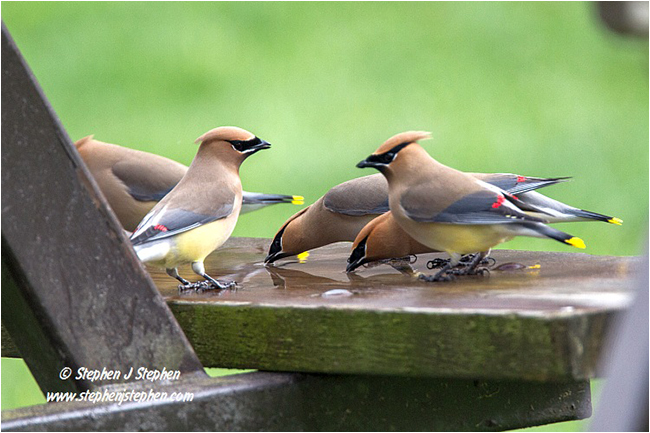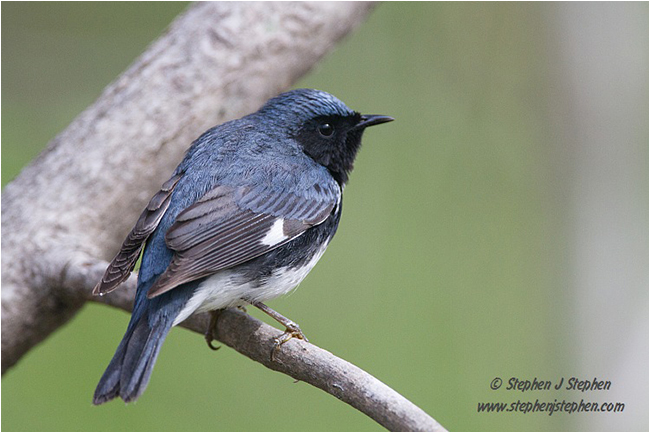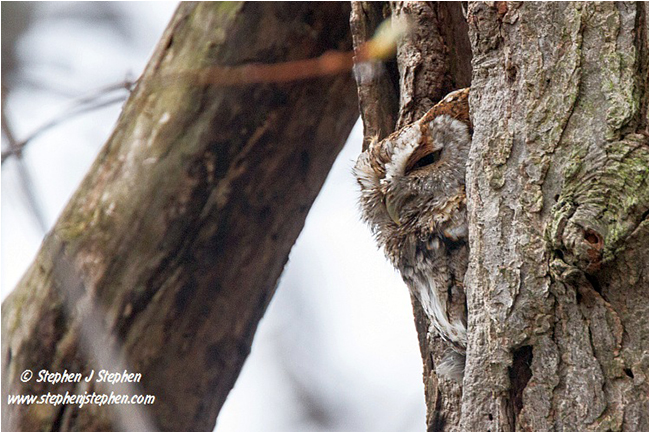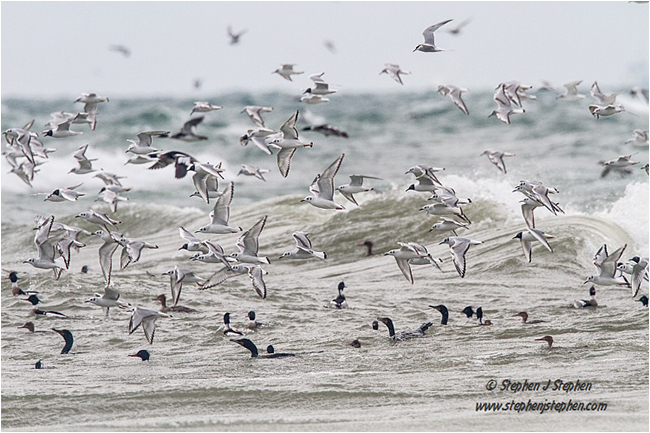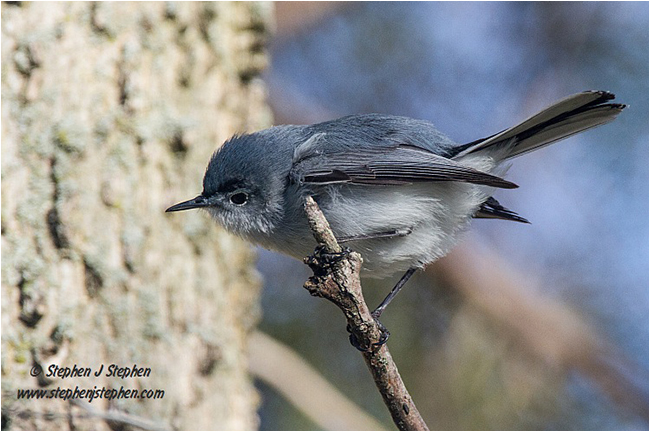
Spring in Point Pelee and Other Southern Ontario Locales
by Stephen J. Stephen
June 30, 2014

Birders gather at Point Pelee
Each year the spring bird migration is long anticipated by Canadian bird lovers and bird photographers alike. This year particularly so after what seemed a very long winter.
Cedar Waxwings
In May, I joined a birding friend of mine, and spent 12 days in and around Point Pelee National Park in southern Ontario during the spring bird migration. Point Pelee is considered one of the top 15 locations worldwide for birding, because of the spring migration, and I had been hoping to visit there for several years. The park's geographical location, as the most southern point of mainland in Canada, makes it an ideal place for exhausted birds arriving in Canada after a long, tiring flight across Lake Erie.
Black-thoated Warbler
Eastern Screech Owl
Our trip had been timed (May 3-15) to coincide with a good part of the “2014 Festival Of Birds”. Even though migration was relatively behind schedule (according to people I met) for the first 3-4 days, I was not disappointed over my whole visit to the park and surrounding areas. In total I added 25 new species to my birding life list and got many new photos. Some of these included: the Smith's Longspur, a species more often seen in Churchill Manitoba; the Yellow-Breasted Chat; the Orchard Oriole as well as the handsome Canada, Black-Throated Blue and Magnolia Warblers.
Everyone at Point Pelee was very friendly and helpful, sharing information about bird sightings and helping others less knowledgeable with identification. Above all they were passionate about birds! Who else rises while its still dark to the songs of the “Dawn Chorus” and arrives at the park's most southernly point before, or just as, the sun rises? What other people have licences plates with names like: 'BIRDMOBL', 'MOT MOT' or 'WHIMBREL'? I met wonderful people who proudly stated that they were back again for the 35th, 36th and even 37th spring!
There were a number of photographers there but by far the largest number of people were birders. Some mornings there were hundreds of people on the beach near the very tip of the point. Some places are reserved for the tired birds and some trails are only seasonal but there are still plenty of opportunities to see birds. Everyone was very respectful of the exclusion zones that were outlined for the protection of the birds.
Orchard Oriole
Protonotary Warbler
Trying to photograph birds in such a busy and crowded location offered some interesting challenges. Birders are often satisfied with a good look at a bird through binoculars or a spotting scope. Sometimes only clearly hearing a song or call that they recognise could be sufficient. A bird photographer on the other hand is always hoping for a “clear shot” and a stationary or at least slower moving target (not an easy thing when dealing with insect-eating birds like warblers). Many eyes helped spot arriving birds but crowded trails made finding a good camera position an adventure at the same time. Often a bird would have moved on before I could get a shot out in the open. Better opportunities often occured later in the day as the crowds had thinned out and more birds had arrived.
Feeding Frenzy
Mourning Dove
Each day brought new adventures and new species. While news of rare bird sightings seemed to pass from birder to birder almost by telepathy, the advent of cell phones has helped them exchange information even faster. You could often see people rushing off in their vehicles in hopes of seeing another rare species. One of the most interesting days was on May 7. A strong wind had been blowing all the night before and when I arrived at the point I saw a wonderful nature experience. Just a short way off from the point, in Lake Erie, a feeding frenzy was going on. I would estimate that 300-400 Red-Breasted Mergansers, 200 or more Double-Crested Cormorants, 200-300 Bonaparte's Gulls, nearly 100 Common Terns and a few other species were all feeding on a very large school of small fish that had obviously “shoaled up” in the shallows. This feeding frenzy went on continuosly for at least 3-4 hours. Throughout that time some birds might leave, or land on the shore to rest, while others would take their place.
Swainsons Thrush
Turkey
I would be remiss if I did not also talk a bit about a wonderful group of volunteers that help make the annual 'Festival of Birds' possible. In particular the “Friends of Point Pelee” deserve a lot of credit. The members of this group wake up each morning, at the crack of dawn, to provide daily food service for the birders and photographers that visit the park. They offer a “Birders Breakfast and Lunch” each day. They also drive the free shuttle (every 12-15 minutes) that takes people from the park Visitor's Centre almost to the tip of the point nearly 2 Kilometres away. Hot coffee, tea or chocolate, topped off with a giant. delicious “Bird Seed” cookie is welcome after a cool first few hours at the point tip! All sales proceeds support the Friends of Point Pelee and Point Pelee National Park.
Blue-Gray Gnatcatcher
In addition to visiting Point Pelee we spent time at nearby Wheatley (where we camped) and Rondeau Provincial Parks. There I saw such species as: a Common Nighthawk and a nesting pair of Northern Flickers at Wheatley and a Tufted Titmouse and the uncommon Protonotary Warbler at Rondeau of which only about 40 pairs are know to breed in Canada.
American Toad
Red Trilliums
While birds were my prime targets I also photographed such varied things as spring wildflowers and singing American Toads. All in all it was a very memorable trip and I would love to return in a couple of years to try my luck again. Armed with my new-found knowledge I'm sure that I will be even better prepared for the photographic challenges next time.
Stephen J Stephen is a nature photographer living in Ottawa, Ontario. Stephen shoots with the Canon 7D and 40D, the Canon 500mm F4 and Sigma EX APO Pro series lenses.
Photo of Stephen by Jim Cumming
Stephen J Stephen
E-mail: info@stephenjstephen.com
Website: www.stephenjstephen.com
See Stephen's previous article on the Canadian Nature photographer
Links that may be of interest
[ Top ]
